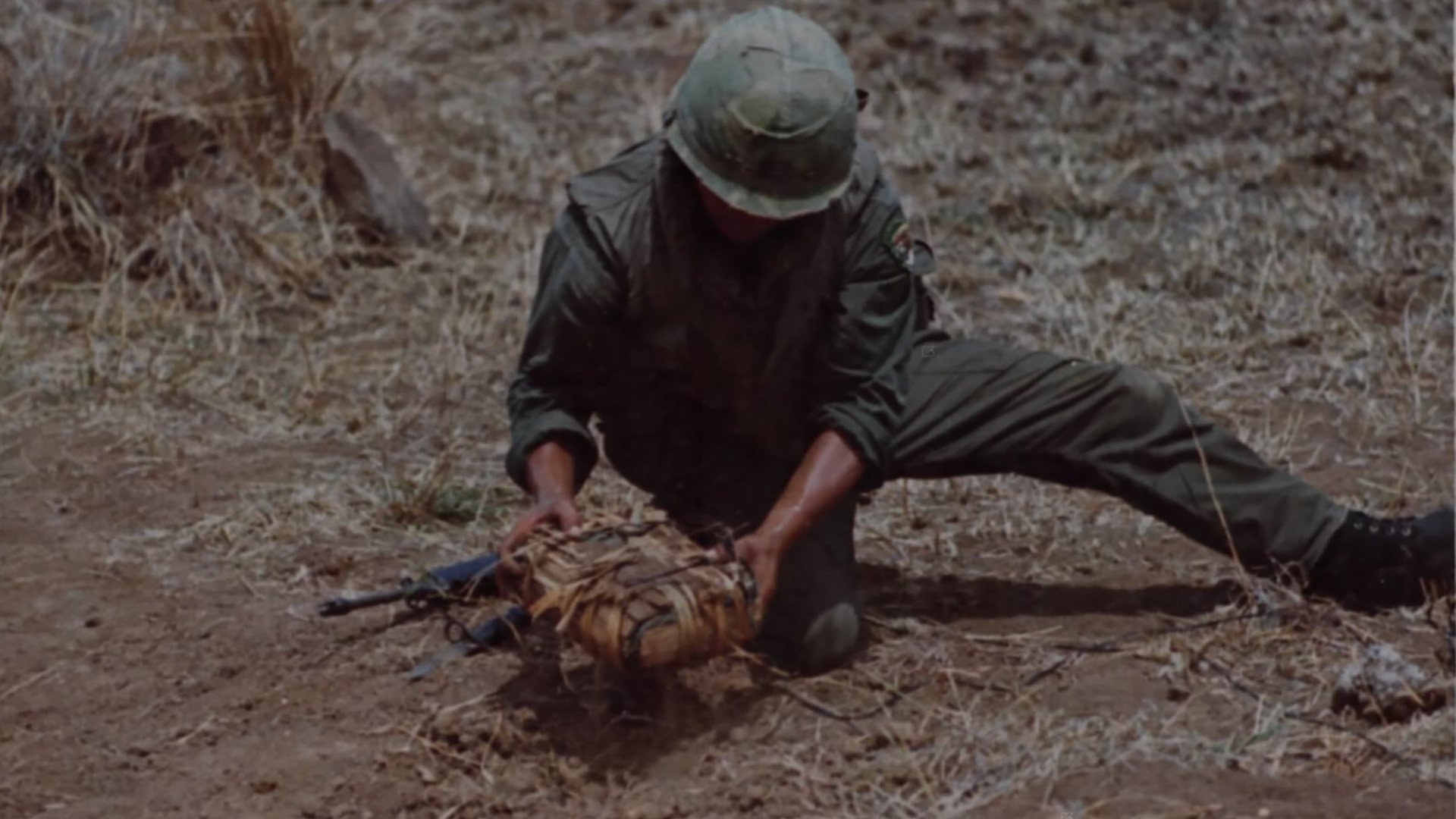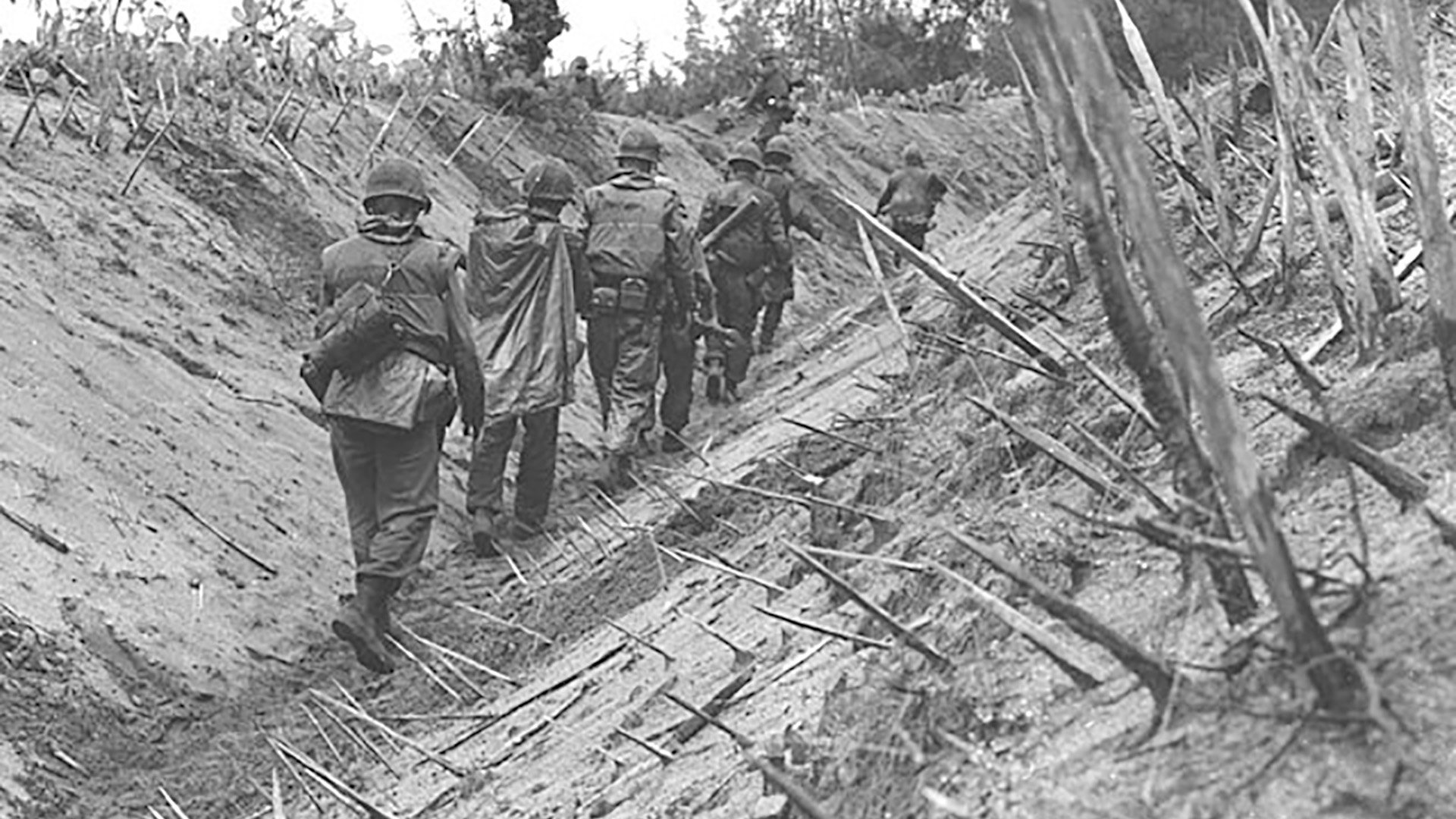5 Terrifying Booby Traps American GIs Encountered in the Vietnam War

A soldier of the 26th Regiment, ROK Tiger Division, lifts a Viet Cong booby-trap from the ground during a demonstration near HQ, Song Cau, 2 September 1969. Wikimedia Commons photo.
What is a booby trap? According to the United Nations' Protocol II of the 1980 Convention on Certain Conventional Weapons, a booby trap is “any device or material which is designed, constructed or adapted to kill or injure and which functions unexpectedly when a person disturbs or approaches an apparently harmless object.”
The term “booby trap” has been in the lexicon of American GIs since at least World War II. In 1944, it was the subject of a Private Snafu instructional video, which joked that “if you are a boob, you will be trapped” — but it wasn’t until the Vietnam War that the devices became so widely used that US troops were evacuated from the battlefield in large numbers because of them. Having used booby traps successfully against the French in the First Indochina War, Vietnamese guerrillas embraced the tactic and employed it frequently after the United States began its military operations in the region. According to a Marine Corps report, between 65% and 75% of all US casualties in the first few months of 1965 resulted from mines and booby traps.
Here are five booby traps that American GIs encountered during that conflict.
Bamboo Whip Traps

The bamboo whip booby trap swung violently into the legs and torsos of those who stepped on the tripwire to initiate the attack. Screenshot courtesy of a US Marine Corps report.
The Viet Cong notoriously targeted US troops with this booby trap during dismounted patrols. These sinister traps were crafted from springy green bamboo sticks, usually between 3 and 10 feet in length. Insurgents affixed barbed-spike plates to one end of the stick, which was then rigged to a tree along a footpath and cocked back like a horizontal catapult. Then, a tripwire was connected to the trap. When the device was triggered, the spiked end of the pole would whip around and strike whoever was in its path, often impaling the victim in their legs or torso.
Mudball Mines

Mudball mines were hand grenades encased in sun-baked mud or clay. Screenshot courtesy of a US Marine Corps report about "Mines and Booby Traps."
Mudball mines were essentially M26 hand grenades and M33 hand grenades encased in sun-baked mud or clay. The Viet Cong removed the safety pin on the hand grenade so that the dried mud or clay held the spoon in position and prevented it from being released. When stepped on, the mud case would crack apart, jostling the spoon to initiate the explosion. Since mudball mines were easily concealed and camouflaged, the device could be easily missed, even by seasoned soldiers.
Cartridge Traps

These so-called cartridge booby traps were essentially land mines, but instead of an explosive, the victim was shot with a bullet. Screenshot courtesy of a US Marine Corps report about "Mines and Booby Traps."
According to one Marine Corps report, so-called cartridge traps were commonly used in the Vietnam War because the four components needed to assemble the booby trap were easily obtainable. The components were a small bamboo tube, a nail, a piece of wood, and any caliber of small-arms ammunition. The bamboo tube was positioned upright on a wooden foundation and nailed in place. Then the ammo cartridge was wedged into the bamboo tube so that the primer of the round touched the tip of the nail. The small contraption was then buried along a foot trail with the round facing up so it would shoot directly into the bottom of someone’s foot. When a soldier stepped on the trap, the pressure forced the primer to strike the nail, firing the round.
Punji Sticks

Company F, 2/4 Marines pass through a punji-staked gulley during Operation Double Eagle on Jan. 30, 1966. Wikimedia Commons photo.
Punji sticks were incorporated into various traps intended for different scenarios troops often encountered while on patrol. The punji sticks were sharpened bamboo stakes or barbed spikes. They were sometimes affixed to the bottoms of wooden boxes that were then buried in the ground on or near a footpath and camouflaged with dirt, or they would be jammed into a field and covered with grass. If the Viet Cong engaged American forces in a gunfight, an unsuspecting GI might dive into the grass for cover and be impaled by the hidden trap. The VC was also known to place punji sticks under bridges beneath false planks, so a GI on patrol would suddenly crash through the bridge and fall into a pit of spikes.
Anti-Helicopter Booby Traps

Booby traps targeted foot soldiers, but also were employed against vehicles including helicopters at landing zones. Screenshot courtesy of a US Marine Corps report about "Mines and Booby Traps."
American forces commonly used Huey helicopters to insert troops into battle and evacuate casualties. The North Vietnamese Army and VC developed countermeasures to attack helicopters while they attempted to land. One tactic involved mounting grenades, mortar rounds, and other explosive devices on trees along the surface of the landing zone. These booby traps were set off when the helicopter hit a tripwire strung between loosely placed poles on the ground. According to the aforementioned Marine Corps report, a 13-year-old Vietnamese boy was once forced by the VC to place hand grenades at various landing zones. The Viet Cong instructed the boy to wrap the grenade’s levers with string and place pieces of paper attached to the ends. The report said that, when a helicopter came in to land, the helicopter’s rotor wash would blow the paper, unwrap the string, and detonate the booby trap.
Read Next: The Forgotten Heroes Who Stopped the My Lai Massacre

Matt Fratus is a history staff writer for Coffee or Die. He prides himself on uncovering the most fascinating tales of history by sharing them through any means of engaging storytelling. He writes for his micro-blog @LateNightHistory on Instagram, where he shares the story behind the image. He is also the host of the Late Night History podcast. When not writing about history, Matt enjoys volunteering for One More Wave and rooting for Boston sports teams.
BRCC and Bad Moon Print Press team up for an exclusive, limited-edition T-shirt design!
BRCC partners with Team Room Design for an exclusive T-shirt release!
Thirty Seconds Out has partnered with BRCC for an exclusive shirt design invoking the God of Winter.
Lucas O'Hara of Grizzly Forge has teamed up with BRCC for a badass, exclusive Shirt Club T-shirt design featuring his most popular knife and tiomahawk.
Coffee or Die sits down with one of the graphic designers behind Black Rifle Coffee's signature look and vibe.
Biden will award the Medal of Honor to a Vietnam War Army helicopter pilot who risked his life to save a reconnaissance team from almost certain death.
Ever wonder how much Jack Mandaville would f*ck sh*t up if he went back in time? The American Revolution didn't even see him coming.
A nearly 200-year-old West Point time capsule that at first appeared to yield little more than dust contains hidden treasure, the US Military Academy said.












